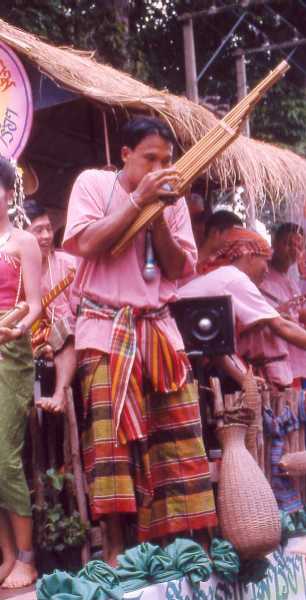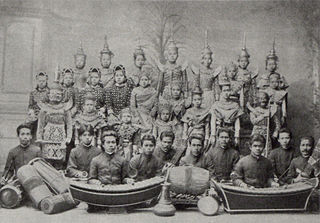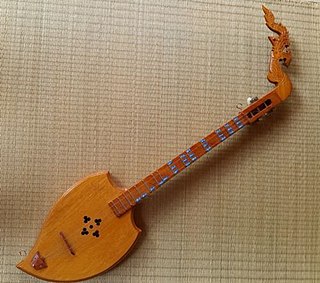This article needs additional citations for verification .(July 2007) |
Traditional Lao music can be divided into classical and folk forms.
This article needs additional citations for verification .(July 2007) |
Traditional Lao music can be divided into classical and folk forms.
The Khene (Lao : ແຄນ) is the instrument most identified with Laotian music. A national proverb says that "a person living under a stilted house, eating sticky rice, listening to any music related to Lam (Lao : ລຳ) or Morlam, and playing the Khene is likely to be Lao or associated with Lao people."
Khenes are made from a special kind of bamboo. It looks slightly Andean in appearance with its sets of bamboo and reed pipes of various lengths, which are strapped together, and then blown into by the player. It can be played solo as in traditional Lao music or in combination with other musical instruments to accompany modern songs.
Vichai Sitviseth, ວິຈັຍ ສິຕວິເສສ/ วิจัย สิตวิเสส As 2023, Vichai Sitviseth is active as Lao Artist, Singer/Song-Writer from Chicago, Illinois USA. His music History:in 1989 Vichai had formed a live Band/Lukthung Neerankalวงดนตรี ลูกทุ่งนิรันดร์กาล as a lead Vocal/guitar in Rockford, Illinois USA. 2000-2005 he joined as a singer วงดนตรี RED ROSE/กุหลาบแดง and SEXY200/แซ็กซี2000 in Santa Rose, California USA. 2005-2009 he had toured music shows for ก วิเสส Koviseth and คำตุ่น วงสนิส Khamtoun and formed Rajasinh Band/วงดนตรี ราชาสิงห์ in Sacramento, California.
laos been over from 13th century form 17th century there style has been In this respect, it differs markedly from the mahori orchestras of Cambodia and Siam. Lao music today comes in a wide variety of styles and from different national origins. Outside of Laos, Lao music is mainly created in the United States, France and Canada. An increasing amount of transnational Lao (alternative) rock, pop and hip hop created a new 'oeuvre' next to the traditional Lao music like morlam.
Most notable Lao hip hop artists from the US are Supasang aka Buc Supa, 'gangsta rapper' Gumby AKA Pryce, Lil Yank from South Carolina, and Goof Loc from Fort Smith, Arkansas. Both rappers, Gumby and Supasang, made music videos and both rap in Lao language.
The most famous Lao artist from France is Willy Denzey, a R&B singer who started his singing career in 2001 and achieved success with his hits "Le mur du son", "L'Orphelin" and "Et si tu n'existais pas" and his successful albums #1 and
The Lao classical orchestra can be divided into two categories, Sep Nyai and Sep Noi (or Mahori). The Sep Nyai is similar to Piphat, and is ceremonial and formal music and includes: two sets of gongs (khong vông), a xylophone (ranat), an oboe (pei or salai), two large kettle drums and two sets of cymbals (sing, similar to Thai ching). The Sep Noi, capable of playing popular tunes, includes two bowed string instruments, the So U and the So I, also known to the Indians. These instruments are similar to the Thai Saw u and Saw duang, respectively. They have a long neck or fingerboard and a small sound box; this sound box is made of bamboo in the So U and from a coconut in the So I. Both instruments have two strings, and the bow is slid between these two strings, which are tuned at a fifth apart and always played together. Furthermore, this mahori or sep noi ensemble (the sep nyai is strictly percussion and oboe) may include several khene. In this respect, it differs markedly from the mahori orchestras of Cambodia and Siam.
Some ethnomusicologists believe the ancient art music of the Khmer people has been best preserved in Laos—along with diverse forms of folk music related to the oldest types of Indian music—music that has largely disappeared in India itself. They claim to find in Laos a scale the ancient Hindus called the "celestial scale," the Gandhara grama—which is a tempered heptatonic scale, or a division of the octave into seven equal parts.
The Royal Lao Orchestra, consisting of musicians of the former court of the king of Laos, who fled Laos following the communist takeover in 1975, now reside in Knoxville and Nashville, Tennessee, United States.
Lao folk music, known as Lam, is extemporaneous singing accompanied by the khene. It is popular both in Laos and Thailand, where there is a large ethnic Lao population.
Following the Siamese conquest of Laos in 1828 and the subsequent dispersion of the Lao population into Siam (Central Thailand), Lao music became fashionable there. Sir John Bowring, an envoy from Great Britain, described a meeting with the deputy king (ouparaja) of Siam in 1855 in which his host performed on the Lao khene; at a meeting two days later he entertained Bowring with Lao dancers and khene music. The Chronicles of the Fourth Reign said the deputy king enjoyed playing the khene and "could perform the Lao type of dance and could skillfully perform the Lao comedy-singing. It is said that if one did not actually see his royal person, one would have thought the singer were a real Lao."
Immediately after the deputy king's death in 1865, King Mongkut made known his fear that Lao musical culture would supplant Siamese genres and therefore banned Lao musical performances in a proclamation in which he complained that, "Both men and women now play Lao khene (mo lam) throughout the kingdom...Lao khene is always played for the topknot cutting ceremony and for ordinations. We cannot give the priority to Lao entertainments. Thai have been performing Lao khene for more than ten years now and it has become very common. It is apparent that wherever there is an increase in the playing of Lao khene there is also less rain."
In recent years Lao popular music has made inroads into Thailand through the success of contemporary Lao musicians Alexandria, L.O.G. and CELLS. CELLS second Lao album 'Saew' was released by Thai label GMM / Grammy in 2007 and received top 20 radio airplay in Bangkok for hit singles 'Waan' and 'Leuk Leuk'. Music videos for 'Waan' and 'Leuk Leuk' have also proved very popular on Thai music video channels and CELLS have made several well received tours of Thailand to promote the album.

The khaen is a Lao mouth organ whose pipes, which are usually made of bamboo, are connected with a small, hollowed-out hardwood reservoir into which air is blown. The khene is the national instrument of Laos. The khene music is an integral part of Lao life that promotes family and social cohesion and it was inscribed in 2017 on the UNESCO Representative List of the Intangible Cultural Heritage of Humanity. It is used among the ethnic Lao Isan and Some tai ethnic groups such as Tai dam In north Vietnam and Lao population of the province of Stung Treng and is used in lakhon ken, a Cambodian dance drama genre that features the khene as the main instrument In Vietnam, this instrument is used among the Tai peoples and the Muong people.

The music of Cambodia is derived from a mesh of cultural traditions dating back to the ancient Khmer Empire, India, China and the original indigenous tribes living in the area before the arrival of Indian and Chinese travelers. With the rapid Westernization of popular music, Cambodian music has incorporated elements from music around the world through globalization.
The music of Laos includes the music of the Lao people, a Tai ethnic group, and other ethnic groups living in Laos. The traditional music of Laos has similarities with the traditional music of Thailand and Cambodia, including the names of the instruments and influences and developments. To categorize Lao music, it seems helpful to distinguish between the nonclassical folk traditions, the classical music traditions and its basic ensembles, and vocal traditions.

The music of Thailand reflects its geographic position at the intersection of China and India, as well as historical trade routes including with Africa, Greece and Rome.

Mor lam is a traditional Lao form of song in Laos and Isan. Mor lam means 'expert song', or 'expert singer', referring to the music or artist respectively. Other romanisations used include mor lum, maw lam, maw lum, moh lam, mhor lum, and molum. In Laos, the music is known simply as lam (ລຳ); mor lam (ໝໍລຳ) refers to the singer.

A piphat is a kind of ensemble in the classical music of Thailand, which features wind and percussion instruments. It is considered the primary form of ensemble for the interpretation of the most sacred and "high-class" compositions of the Thai classical repertoire, including the Buddhist invocation entitled sathukan as well as the suites called phleng rueang. It is also used to accompany traditional Thai theatrical and dance forms including khon, lakhon, and shadow puppet theater.

The Rocket Festival is a merit-making ceremony traditionally practiced by ethnic Lao people at the beginning of the wet season in various villages and municipalities in Northeastern Thailand and Laos. The festivities typically include music and dance performances, competitive processions of floats, dancers and musicians on the second day, and culminating on the third day with the competitive firing of homemade rockets. Local participants and sponsors take advantage of the occasion to enhance their social prestige, as is customary in traditional Buddhist folk festivals throughout Southeast Asia.

Romvong, Lamvong or Ramwong, Rambung, Vietnamese: lăm-vông) is a type of Southeast Asian dance where both females and males dance in a circle. It is a popular folk-dance in Xishuangbanna (China), Cambodia, Laos, Malaysia and Thailand. It is a slow round dance continuously moving in a circular manner, and incorporates graceful hand movements and simple footwork. Both men and women participate in the same circle.

Wong khrueang sai is a musical ensemble in Thai classical music which consists primarily of string instruments. A typical khrueang sai ensemble features two two-string fiddles, one high and one low, a three-string zither called jakhe, a vertical duct flute called khlui, hand drums, and various cymbals. Depending on the size of the ensemble, instruments may be doubled or left out. A three-string spike fiddle called saw sam sai may be added as well. The khim has become popular and is also used in this ensemble. In the 20th century, Western instruments such as the violin or organ have also occasionally been integrated into khrueang sai ensembles.

Laos developed its culture and customs as the inland crossroads of trade and migration in Southeast Asia over millennia. As of 2012 Laos has a population of roughly 6.4 million spread over 236,800 km2, yielding one of the lowest population densities in Asia. Yet the country of Laos has an official count of over forty-seven ethnicities divided into 149 sub-groups and 80 different languages. The Lao Loum have throughout the country's history comprised the ethnic and linguistic majority. In Southeast Asia, traditional Lao culture is considered one of the Indic cultures.
The dance and theatre of Laos is the primary dramatic art form of Laos' majority ethnic group, the Lao people. It is shared with the ethnic Lao that inhabit the Isan region of Thailand as well. There are mainly two types of dances, the classical dances performed in the royal courts and the folk dances now associated with morlam.
Lam saravane is a popular folksong originally from the southern province of Saravane Province of Laos, but popular throughout the Lao-speaking world, including the Isan region of Thailand, but it is also regarded as a traditional folksong and dance of Khmer culture. It is possible that the melody was borrowed from the Khmer or related Mon-Khmer groups and later re-popularised later by its recent rise of popularity in Laos and Isan.

Pi is the generic term for any of a variety of quadruple reed oboes used in the traditional music of Thailand, piphat. It is very similar in construction and playing technique to Burmese Hne and Cambodian sralai.

The gourd mouth organ is a free reed mouth organ played across East and Southeast Asia. It consists of a gourd wind chest with several bamboo or bronze pipes inserted on top of it, the numbers of pipes differing from region to region.

The Roneat Ek or Roneat Aek is a xylophone used in the Khmer classical music of Cambodia. It is built in the shape of a curved, rectangular shaped boat. It has twenty-one thick bamboo or hard wood bars that are suspended from strings attached to the two walls. They are cut into pieces of the same width, but of different lengths and thickness. Originally these instruments were highly decorated with inlay and carvings on the sides of the sound box. Now they are simpler. The Roneat is played in the Pinpeat ensemble. In that ensemble, sits on the right of the Roneat Thung, a lower-pitched xylophone. The roneat ek is the analogous equivalent to the Thai xylophone called ranat ek, and the Burmese bamboo xylophone called "pattala".

The phin (Thai: พิณ, pronounced[pʰīn], is a type of lute with a pear-shaped body, originating in the Isan region of Thailand and played mostly by ethnic Laotians in Thailand and Laos. It has frets on the neck over which two or three metal strings run that are plucked by a pick held in the right hand while playing. It is often played together with the khene mouth organ.
Lao pop or L-pop is a music genre of pop music of Lao people.

Bamboo's natural hollow form makes it an obvious choice for many musical instruments. In South and South East Asia, traditional uses of bamboo the instrument include various types of woodwind instruments, such as flutes, and devices like xylophones and organs, which require resonating sections. In some traditional instruments bamboo is the primary material, while others combine bamboo with other materials such as wood and leather.
Pinphat is a traditional Lao ensemble used to accompanied in Laotian shadow theater and masked theater Phralak Phralam, the Laotian version of Indian Ramaya. This ensemble was adopted from the Khmer orchestra.